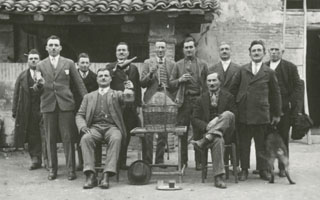Racking and consumption

Racking is a traditional method in wine production of moving wine from one barrel to another (tramudèr al vén dapp cl a buié intal tinàz) to eliminate the sediment (fònd) from fermentation This was customarily done for St. Martin’s Day (11 November), Christmas and Easter - ideally on a mild day without wind during a descending moon phase - using a rubber tube (bigàt) or a thin funnel in the form of a straw, or occasionally actual filters. Once the first phase of fermentation was complete, the barrels and demijohns were closed with stoppers of cork or wood and their contents were periodically topped off.
Until late spring, it was customary to drink the “second wines”. With the start of heavy labor in summer, the pure wine conserved in barrels or demijohns was brought to the table and out to the worksites in an array of containers: pitchers (mzatta), flasks (zucàtt, zócca, zucòuna, or, depending on their size, fiasch, fiascòn), large bottles (butigliòn), including those made from pumpkins (zócca dal pelgrén), from terracotta (fiasch ed teracòta) and from straw (fiascòn) or smaller bottles (budgénna, barilén).
Only a small portion of the wine was bottled and saved for holidays and special occasions. The bottling machine (màchina da imbutiglièr) came into use in the mid-1900s. Stoppers made of cork (stupài,óvar) were often lubricated with olive oil and then inserted with a corking machine (màchina da stupèr al butégli).